Related Research Articles
Lazzi are stock comedic routines that are associated with Commedia dell'arte. Performers, especially those playing the masked Arlecchino, had many examples of this in their repertoire, and would use improvisatory skills to weave them into the plot of dozens of different commedia scenarios. These largely physical sequences could be improvised or preplanned within the performance and were often used to enliven the audience when a scene was dragging, to cover a dropped line or cue, or to delight an expectant audience with the troupe's specialized lazzi.

Socialist realism is a style of idealized realistic art that was developed in the Soviet Union and was the official style in that country between 1932 and 1988, as well as in other socialist countries after World War II. Socialist realism is characterized by the depiction of communist values, such as the emancipation of the proletariat. Despite its name, the figures in the style are very often highly idealized, especially in sculpture, where it often leans heavily on the conventions of classical sculpture. Although related, it should not be confused with social realism, a type of art that realistically depicts subjects of social concern, or other forms of "realism" in the visual arts. Socialist realism was made with an extremely literal and obvious meaning, usually showing an idealized USSR. Socialist realism was usually devoid of complex artistic meaning or interpretation.
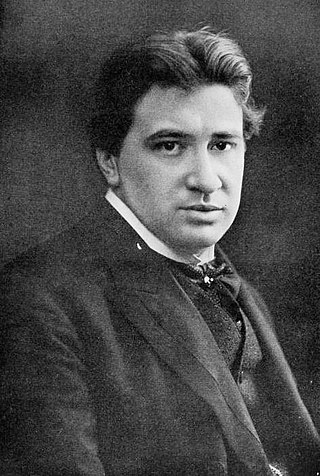
Ermanno Wolf-Ferrari was an Italian composer and teacher. He is best known for his comic operas such as Il segreto di Susanna (1909). A number of his works were based on plays by Carlo Goldoni, including Le donne curiose (1903), I quatro rusteghi (1906) and Il campiello (1936).

Gian Francesco Malipiero was an Italian composer, musicologist, music teacher and editor.
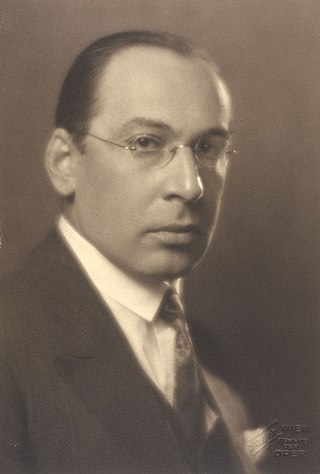
Alfred Einstein was a German-American musicologist and music editor. He was born in Munich and fled Nazi Germany after Hitler's Machtergreifung, arriving in the United States by 1939. He is best known for being the editor of the first major revision of the Köchel catalogue, which was published in the year 1936. The Köchel catalogue is the extensive catalogue of the works of Wolfgang Amadeus Mozart.

Hannah Höch was a German Dada artist. She is best known for her work of the Weimar period, when she was one of the originators of photomontage. Photomontage, or fotomontage, is a type of collage in which the pasted items are actual photographs, or photographic reproductions pulled from the press and other widely produced media.
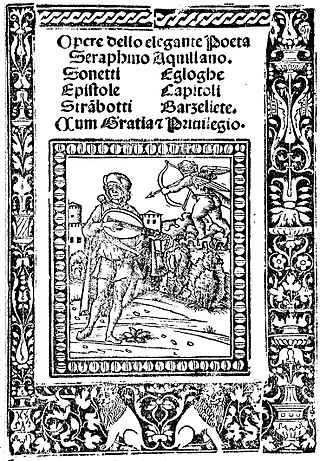
The Italian poet and musician Serafino dell'Aquila or Aquilano is alternatively named Serafino dei Ciminelli from the family to which he belonged. He was born in what was then the Neapolitan town of L'Aquila on 6 January 1466 and died of a fever in Rome on 10 August 1500. As a writer he was one of the foremost of the stylistic followers of Petrarch and his work was later influential on both French and English Petrarchan poets.

Euphronios was an ancient Greek vase painter and potter, active in Athens in the late 6th and early 5th centuries BC. As part of the so-called "Pioneer Group,", Euphronios was one of the most important artists of the red-figure technique. His works place him at the transition from Late Archaic to Early Classical art, and he is one of the first known artists in history to have signed his work.

The Alabama Centennial half dollar, or Alabama half dollar, was a commemorative fifty-cent coin struck by the United States Bureau of the Mint in 1921 as a belated acknowledgement of the 100th anniversary of Alabama's admission to the Union in 1819. The coin was created by Laura Gardin Fraser, the first woman credited with designing a coin.

The Gero Cross or Gero Crucifix, of around 965–970, is the oldest large sculpture of the crucified Christ north of the Alps, and has always been displayed in Cologne Cathedral in Germany. It was commissioned by Gero, Archbishop of Cologne, who died in 976, thus providing a terminus ante quem for the work. It is carved in oak, and painted and partially gilded – both have been renewed. The halo and cross-pieces are original, but the Baroque surround was added in 1683. The figure is 187 cm high, and the span of its arms is 165 cm. It is the earliest known Western depiction of Christ on the cross while dead; earlier depictions had Christ appearing alive.
Italian music terminology consists of words and phrases used in the discussion of the music of Italy. Some Italian music terms are derived from the common Italian language. Others come from Spanish, or Neapolitan, Sicilian, Sardinian or other regional languages of Italy. The terms listed here describe a genre, song form, dance, instrument, style, quality of music, technique or other important aspect of Italian music.

Water Lilies is a series of approximately 250 oil paintings by French Impressionist Claude Monet (1840–1926). The paintings depict his flower garden at his home in Giverny, and were the main focus of his artistic production during the last thirty years of his life. Many of the works were painted while Monet suffered from cataracts.

Rubber hose animation was the first animation style that became standardized in the American animation field. The defining feature is the curving motion most things possess, resembling that of a rubber hose. While the style fell out of fashion during the 1930s, there has been a minor revitalization of it in recent years with works such as the video games Cuphead and Bendy and the Ink Machine, and the film Steven Universe: The Movie.

Mexican Muralism refers to the art project initially funded by the Mexican government in the immediate wake of the Mexican Revolution (1910-1920) to depict visions of Mexico's past, present, and future, transforming the walls of many public buildings into didactic scenes designed to reshape Mexicans' understanding of the nation's history. The murals, large artworks painted onto the walls themselves had social, political, and historical messages. Beginning in the 1920s, the muralist project was headed by a group of artists known as "The Big Three" or "The Three Greats". This group was composed of Diego Rivera, José Clemente Orozco and David Alfaro Siqueiros. Although not as prominent as the Big Three, women also created murals in Mexico. From the 1920s to the 1970s, many murals with nationalistic, social and political messages were created in many public settings such as chapels, schools, government buildings, and much more. The popularity of the Mexican muralist project started a tradition which continues to this day in Mexico; a tradition that has had a significant impact in other parts of the Americas, including the United States, where it served as inspiration for the Chicano art movement.

Enghaveparken is a public park in the Vesterbro district of Copenhagen, Denmark. It was laid out in the late 1920s to cater for the citizens of the expanding city. The park is completely closed off while undergoing comprehensive renovations June 2018-December 2019.
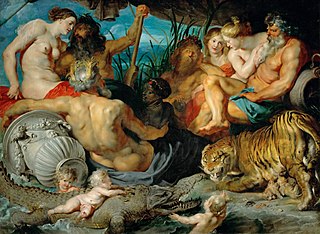
The Four Continents, also known as The Four Rivers of Paradiseor The Four Corners of the World, is a painting by Flemish artist Peter Paul Rubens, made between 1612 and 1615. Rubens painted this piece during a time of truce in the Eighty Years' War known as the Twelve Years' Truce. The painting itself is depicts the female personifications of the four continents with the male personifications of their respective major rivers. The painting also depicts three putti in the foreground along with a crocodile, tigress, and her three cubs. An important figure in this piece is the woman in the middle who personifies Africa. She was one of the two black women Rubens painted at the time.

The Pilgrim Tercentenary half dollar or Pilgrim half dollar was a commemorative fifty-cent coin struck by the United States Bureau of the Mint in 1920 and 1921 to mark the 300th anniversary (tercentenary) of the arrival of the Pilgrims in North America. It was designed by Cyrus E. Dallin.

Machinery is a 1920 drawing by American artist Charles Demuth. The drawing depicts a piece of industrial machinery in his hometown of Lancaster, Pennsylvania. The work is currently in the collection of the Metropolitan Museum of Art.

In 1635, Peter Paul Rubens created Venus and Adonis, now in the Metropolitan Museum of Art, New York. He followed the mythological story in the Metamorphoses by Ovid, inspired from his love of classical literature and earlier depictions of this scene. This oil on canvas painting shows Venus accompanied by Cupid, embracing and pulling Adonis before he goes off to hunt. The artist uses specific colors, detail and strong contrast between light and dark to depict a dramatic and emotional scene. At the time Rubens created the painting, the mythological story of Venus and Adonis was popular in Renaissance and Baroque court art. Rubens was clearly inspired by the many existing depictions of this scene, in particular the famous Titian composition of the same name, of which there are numerous versions. This depicts the same moment of Adonis leaving Venus to hunt, despite her pleas to stay. He is killed later in the day.
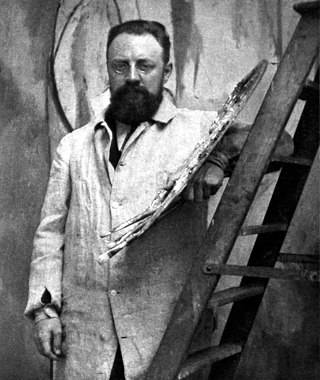
French visual artist Henri Matisse was known for his use of color and draughtsmanship. In the early 20th century, Matisse became a leader of the Fauvism art movement, which was an early movement in the broader Post-impressionist era.
References
- David Ewen, Encyclopedia of Concert Music. New York; Hill and Wang, 1959.